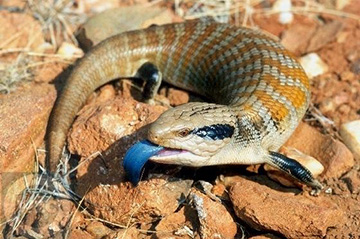One of the pleasures of being an old golf Hacker is that thanks to your power drive often taking a wayward direction, you have the enjoyment of wandering the outer reaches of the Sanctuary Lakes Golf course in search of your ball. Unlike the lower handicappers who have the boredom of never seeming to leave the fairway, the Hacker has the pleasure of tip toeing through the rough and often viewing an unusual ground bird or an unexpected flora and even sometimes, the occasional beastie.
So it was last month, after another wayward drive, I was searching for my ball near a neat clump of Salt Bushes and there sunning itself was a big headed 40 cm long grey and brown striped lizard with almost comical short legs and small feet. As it opened its mouth, I remembered my conversation some 24 hours before with Victoria Park Ranger Bernie, that there had been numerous sightings around the Point Cook Park and wetlands of the Common or Eastern Blue Tongue Lizards. And here I was Face to Blue Tongue, so to speak, with one of their number.
 Common or Eastern Blue Tongue Lizard
Common or Eastern Blue Tongue Lizard
(Tiliqua scincoides)Startled by my presence the Lizard went into defensive mode, opened a large pink mouth and stuck out an even larger, bright vivid and almost unnatural blue tongue. Hissing loudly and then flattening the body making it look wider and bigger, all designed to frighten any attacker.
I had been warned never to pick up a Blue Tongue in defence mode. It will bite you and it will hurt. Fortunately, they are not poisonous, but Blue Tongues have a nasty habit of using their strong jaws, latching onto your finger and not letting go, leaving you with a very unpleasant bruise.
Picking them up incorrectly can also pull off their tails. Although technically a defence mechanism to help them escape predators, this process isn’t very good for them, especially in winter, as their tail is where they store their water and nutrients and it requires a lot of energy to regrow them.
As the name suggests the Common Blue Tongues are very common. They like open country and golf courses with their covering of tall grasses, leaf litter, burrows, low shrubs etc. under which they will shelter at night. During the day, they sun themselves until they are warm enough, and then they forage for food. Their diet consists of plant matter and small animals that can be beetles, caterpillars, crickets, snails and even other small lizards. Anything they can get hold of will do, but they are not very fast, so they usually eat the slow movers. Therefore, they are very partial to slugs and snails.
Blue-tongues live alone for most of the year, but between September and November males pursue females and mating occurs. At this time, males may fight aggressively among themselves. Mating may be rough, with females carrying scrape marks from the male's teeth.
Female Blue Tongues give birth three to five months after mating, between December and April. As long as there has been sufficient food supply they will breed annually, but if there has been a food shortage or drought they may skip a year.
Unlike most reptiles Blue Tongues do not lay eggs. The embryos develop in the female's oviduct with the help of a placenta, which is as well-developed as that of many mammals. At birth, the young eat the placental membranes, and within a few days shed their skin for the first time. The young are ready to look after themselves straight after birth, and disperse within a few days.
Blue Tongues have very large litters, up to 25 young are born at a time. The young are very small measuring 130-140 mm in total length and weighing 10-20 g. Their smallness and lack of speed make them very available to predators. Currawongs, Kookaburras, Raptors and Snakes all enjoy feasting on baby Blue Tongue. Survival is also decreased by wild and domestic cats and dogs who do not use them as a food supply but as a sport.
Sadly, the loss can be as high as 80% of a litter. Those that do survive probably become adults at about three years of age when they have a total length of about 40cm. Those that reach adulthood have surprisingly long lives. Several captive animals have lived for 25 years, and those in the wild may live much longer.
At the onset of winter, all Blue Tongues enter a dormant phase, though this is not a true hibernation. On the warmer winter days, they may come out to bask for short periods but no feeding takes place. As the weather hots up in spring the lizards emerge to warm their bodies and start looking for mates.
The Common Blue Tongue has lived on our Western Basalt Plain for thousands of years and although beautifully camouflaged, they are not rare. Sanctuary Lakes' gardeners and groundsmen tell me they regularly see them around the estate. The area abounds in their favourite foods and the Blue Tongues in turn help in a natural manner to keep down the number of snails, slugs and plant-eating insects.
Finally, one more festinating fact, the Blue Tongue lizard has a 'third eye' on top of its head. It is a small hole leading down to its brain that it uses to work out when its night or day, and it helps regulate their body temperature. Now that is something for Spec Savers to think about.